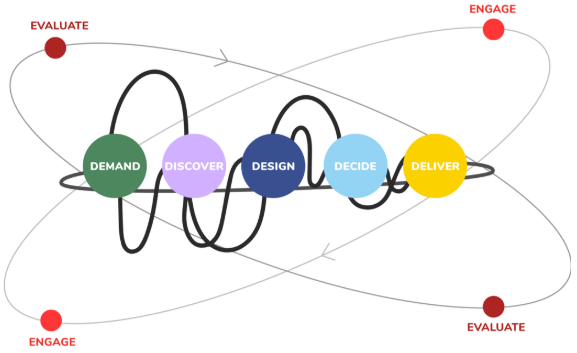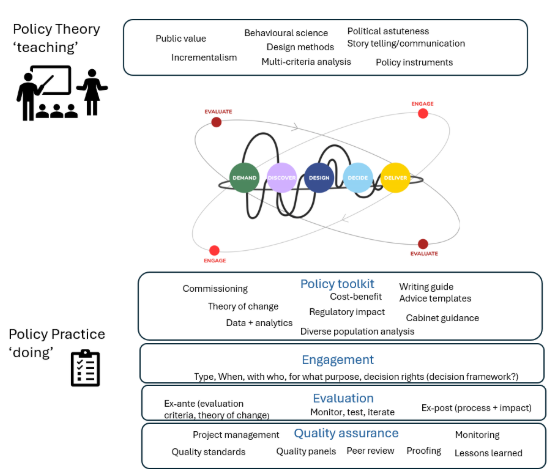
In this article, first published in The Mandarin, ANZSOG Practice Fellow Sally Washington looks at how to build a repeatable, scalable model policy process model, and how governments can support the development of high-quality policy advice. This article covers the importance of engagement and evaluation, and the need for fearless and frank delivery of policy advice.
Good government decision making depends on good policy advice, whether it is accepted or not. As public servants contemplate how to best advise new ministers or how to refresh their service to the same minister, they should reflect on the ‘how’ of policy.
Too often policy improvement initiatives are limited to better training for policy staff. From my experience, supporting a range of organisations and jurisdictions to improve their policy advice, the key to improvement lies in a systemic approach. I frame this as building an effective policy infrastructure. But I’ve found the missing link in many policy systems is a repeatable, scalable policy process model. Such a model can serve as both guardrails for policy staff developing policy advice and as an anchor for supporting architecture like policy quality assurance processes, policy methods and toolkits, and other requirements like those included in Cabinet manuals and other advisory requirements. Enter the 5D policy advice model.
I shared the fledgling 5D model in a previous article. In a recent publication, my ANZSOG colleague, Chris Walker and I further articulate the 5Ds in the model and document how we have tested and refined it through engagement with senior officials across Australia and Aotearoa (and beyond) as well as academic colleagues. Our goal has been to design a policy advice model that is ‘useful for teaching’ and ‘useful for doing’. Across our engagements we found that less than half (40%) responded that their organisation had some formal guidance to follow when developing policy advice. Reassuringly, the vast majority (90%) also said that the 5D model captured aspects of their practice and a similar proportion expressed interest in adopting the 5D model. Our academic colleagues confirmed that the model would be useful for their teaching. So what’s in the model and how might it be operationalised?
D-words: from Demand to Delivery
The 5D defines a repeatable, scalable policy advice process, designed to support policy professionals in their day-to-day work. It is inquiry driven or questions-based rather than prescriptive of consecutive steps or actions to be taken. Key lines of inquiry are:
- Demand – where is the demand for change coming from, why now?
- Discover – what do we know about the challenge or opportunity, and what do we need to know?
- Design – what methods will we use to design and test solutions, and who needs to be involved?
- Decide – how do we ensure we give quality advice to help decision-makers take good decisions?
- Deliver – how do we ensure decisions will be implemented and have the desired impact?

Figure 1. The 5D policy advice model (see the animation) credit Sally Washington
By providing guidance that is repeatable and scalable, the model moves policy advice from an unspecified or personalized ‘craft’ activity to a more rational and expert process, thereby potentially offering more consistent policy performance within agencies and across government.
E-words: Engagement and Evaluation to enhance Evidence
The model also stresses that engagement and evaluation should occur throughout the policy process. Engagement with those affected by policy decisions – people needing services, businesses being regulated, taxpayers and other stakeholders, and groups who don’t usually have a voice in the policy process – is crucial for policy success. Engagement provides evidence on how people live their lives as well as intelligence on implementation and on how decisions will land. Regular engagement with others in the policy value chain – including decision makers/ministers and frontline delivery staff – is also a factor in policy success.
Policy advice also needs to draw on evaluation or critical assessments of what’s working or not in current arrangements. Maintaining an evaluation mindset and monitoring the real time impact of policy builds the evidence base to support adjustments or innovation in future policy advice. Engagement and evaluation are crucial sources of evidence for policy. They are presented in the 5D model as part of each of the 5 Ds and as part of the dynamics or the iterative nature of a policy process.
Putting it into practice – and theory
How might organisations and jurisdictions make use of the 5D model? In ANZSOG’s work with organizations, we know that adopting the 5D model would require adaptation to context, including to build existing processes into the guidance for using the model.
Rather than reinventing the wheel, the model can support alignment of the cogs in the wheel. Building a toolkit of methods under the 5D model (to support practitioners) and of theories and frameworks into which the model fits (to support teaching academics and other training providers) would enhance its utility (see Figure 2 – illustrative not exhaustive).
I’m encouraged that the Irish government will launch a Policy Handbook this month drawing on the 5D model (exposed to them as part of my role in an OECD analysis of their policy systems).

Figure 2. The 5D as an anchor for Policy Teaching and Policy Practice.
F-words: Free, Frank and other characteristics of quality advice
But will good process lead to good advice? How would we know? What does quality advice look like? Both the Australian and the Aotearoa New Zealand public services have articulated the characteristics of quality policy advice. They are strikingly similar. The Aotearoa Policy Quality Framework defines quality advice in terms of:
- Context – tells the why
- Analysis – is clear, logical, evidence-informed
- Advice – engages the decision maker and tells the full story
- Action – identifies who’s doing what next.
The APS Delivering Great Policy framework articulates ‘great’ advice as being:
- Clear on intent
- Well-informed
- Practical to implement
- Influential (with decision makers)
As far as I know, Aotearoa is the only jurisdiction that has a comprehensive quality assurance regime to measure and report on quality based on these defined quality characteristics. Moreover, any department with policy appropriations is required to report on quality scores in their annual report.
Ministers and senior leaders setting out their expectations of quality provide powerful incentives to focus on the quality of advice. While Secretary of DPMC in Aotearoa and Head of the Policy Profession, Andrew Kibblewhite used F-words to describe his view of quality: free and frank (speak truth to power), full (incorporating all available evidence and multiple perspectives), focused (on outcomes), without favour (politically neutral but politically savvy), fearless (proposing innovative solutions), fallible (includes evaluation and assumptions that can be tested), and future-focused (includes long-term outcomes not just short term fixes). If I were to stretch the theme further, I’d add some c-words: collaborate, coordinate, communicate and other co-s (co-design, co-deliver). But maybe that’s for another article.
The 5D provides an anchor on which to hook policy toolkits, engagement guidance, evaluation and quality assurance processes, to both ensure and assure the quality of advice to decision makers.
Take a test drive?
How to build traction with practitioners is a challenge, as it is in any change programme. We need to understand what might support them to operationalize the model within their teams and organizations. In my work, in the Aotearoa Policy Project and elsewhere, I use the mantra “easy to use, hard to avoid”. Guidance should be relevant and accessible – the 5D is simple without being simplistic, while the animation of the model resonated strongly in our engagements. Uptake can be incentivised by aligning it with performance management and other accountability mechanisms and positioning it as part of wider public sector reform initiatives (which might also include a focus on policy capability in overall organisational capability reviews).
I encourage policy teams, organisations and jurisdictions to take the 5D for a test drive. We hope it works in practice, and in theory. Let us know.
This animation of the 5D model provides a summary of its key features.
Ms Washington has written a range of other articles for ANZSOG, including the recent articles below on policy advice:
